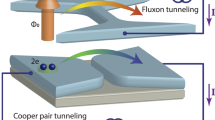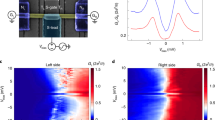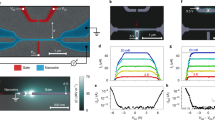Abstract
It is of fundamental importance to establish whether there is a limit to how thin a superconducting wire can be, while retaining its superconducting character—and if there is a limit, to determine what sets it. This issue may also be of practical importance in defining the limit to miniaturization of superconducting electronic circuits. At high temperatures, the resistance of linear superconductors is caused by excitations called thermally activated phase slips1,2,3,4. Quantum tunnelling of phase slips is another possible source of resistance that is still being debated5,6,7,8. It has been theoretically predicted8 that such quantum phase slips can destroy superconductivity in very narrow wires. Here we report resistance measurements on ultrathin (≲10 nm) nanowires produced by coating carbon nanotubes with a superconducting Mo–Ge alloy. We find that nanowires can be superconducting or insulating depending on the ratio of their normal-state resistance (RN) to the quantum resistance for Cooper pairs (Rq). If RN < Rq, quantum tunnelling of phase slips is prohibited by strong damping, and so the wires stay superconducting. In contrast, we observe an insulating state for RN > Rq, which we explain in terms of proliferation of quantum phase slips and a corresponding localization of Cooper pairs.
This is a preview of subscription content, access via your institution
Access options
Subscribe to this journal
Receive 51 print issues and online access
$199.00 per year
only $3.90 per issue
Buy this article
- Purchase on Springer Link
- Instant access to full article PDF
Prices may be subject to local taxes which are calculated during checkout



Similar content being viewed by others
References
Langer,J. S. & Ambegaokar,V. Intrinsic resistive transition in narrow superconducting channels. Phys. Rev. 164, 498–510 (1967).
McCumber,D. E. & Halperin,B. I. Time scale of intrinsic resistive fluctuations in thin superconducting wires. Phys. Rev. B 1, 1054–1070 (1970).
Tinkham,M. Introduction to Superconductivity 2nd edn, 288 (McGraw Hill, New York, 1996).
Ivlev,B. I. & Kopnin,N. B. Electric currents and resistive states in thin superconductors. Adv. Phys. 33, 47–114 (1984).
Van Run,A. J., Romijn,J. & Mooij,J. E. Superconducting phase coherence in very weak aluminium strips. Jpn J. Appl. Phys. 26, 1765– 1766 (1987).
Giordano,N. Evidence for macroscopic quantum tunneling in one-dimensional superconductors. Phys. Rev. Lett. 61, 2137– 2140 (1988).
Duan,J.-M. Quantum decay of one-dimensional supercurrent: role of electromagnetic field. Phys. Rev. Lett. 74, 5128– 5132 (1995).
Zaikin,A. D., Golubev,D. S., van Otterlo, A. & Zimanyi,G. T. Quantum phase slips and transport in ultrathin superconducting wires. Phys. Rev. Lett. 78, 1552–1555 (1997).
Likharev,K. K. & Zorin,A. B. Theory of the Block-wave oscillations in small Josephson junctions. J. Low Temp. Phys. 59 , 347–382 (1985).
Averin,D. V. Solid-state qubits under control. Nature 398, 748–749 (1999).
Caldeira,A. D. & Leggett,A. J. Influence of dissipation on quantum tunneling in macroscopic systems. Phys. Rev. Lett. 46, 211–214 ( 1981).
Schön,G. & Zaikin,A. D. Quantum coherent effects, phase transitions, and the dissipative dynamics of ultra small tunnel junctions. Phys. Rep. 198, 237–412 (1990).
Bulgadaev,S. A. Phase diagram of a dissipative quantum system. JETP Lett. 39, 315–319 (1984).
Schmid,A. Diffusion and localization in a dissipative quantum system. Phys. Rev. Lett. 51, 1506–1509 (1983).
Penttila,J. S., Hakonen,P. J., Paalanen,M. A. & Sonin,E. B. “Superconductor-insulator transition” in a single Josephson junction. Phys. Rev. Lett. 82, 1004– 1007 (1999).
Zaikin,A. D., Golubev,D. S., van Otterlo, A. & Zimanyi,G. T. Quantum fluctuations and dissipation in thin superconducting wires. Usp. Fiz. Nauk 168, 244–248 (1998).
Bezryadin,A., Dekker,C. & Schmid,G. Electrostatic trapping of single conducting nanoparticles between nanoelectrodes. Appl. Phys. Lett. 71, 1273–1275 (1997).
Graybeal,J. M. & Beasley,M. R. Localization and interaction effects in ultrathin amorphous superconducting films. Phys. Rev. B 29, 4167–4169 (1984).
Oreg,Y. & Finkelstein,A. M. Suppression of Tc in superconducting amorphous wires. Phys. Rev. Lett. 83, 191–194 (1999).
Goldman,A. M. & Marković,N. Superconductor-insulator transition in the two-dimensional limit. Phys. Today 51, 39–44 (1998).
Mooij,J. E. & Schön,G. Propagating plasma mode in thin superconducting filaments. Phys. Rev. Lett. 55, 114–117 (1985).
Acknowledgements
We thank E. Demler, Y. Oreg and D. S. Fisher for discussions about their QPS theory, M.Bockrath, B. I. Halperin, L. Levitov, J. E. Mooij, C. van der Wal, R. M. Westervelt and A.D. Zaikin for discussions about other aspects of the work, and S. Shepard for help with fabrication. This work was supported in part by the NSF and ONR.
Author information
Authors and Affiliations
Corresponding author
Rights and permissions
About this article
Cite this article
Bezryadin, A., Lau, C. & Tinkham, M. Quantum suppression of superconductivity in ultrathin nanowires. Nature 404, 971–974 (2000). https://doi.org/10.1038/35010060
Received:
Accepted:
Issue Date:
DOI: https://doi.org/10.1038/35010060
This article is cited by
-
Compact description of quantum phase slip junctions
npj Quantum Information (2023)
-
Non-conventional superconductivity in magnetic In and Sn nanoparticles
Scientific Reports (2022)
-
Magnetic field enhanced critical current and subharmonic structures in dissipative superconducting gold nanowires
Quantum Frontiers (2022)
-
Effect of Focused Ion Beam Irradiation on Superconducting Nanowires
Journal of Superconductivity and Novel Magnetism (2022)
-
Superconducting insulators and localization of Cooper pairs
Communications Physics (2021)
Comments
By submitting a comment you agree to abide by our Terms and Community Guidelines. If you find something abusive or that does not comply with our terms or guidelines please flag it as inappropriate.



